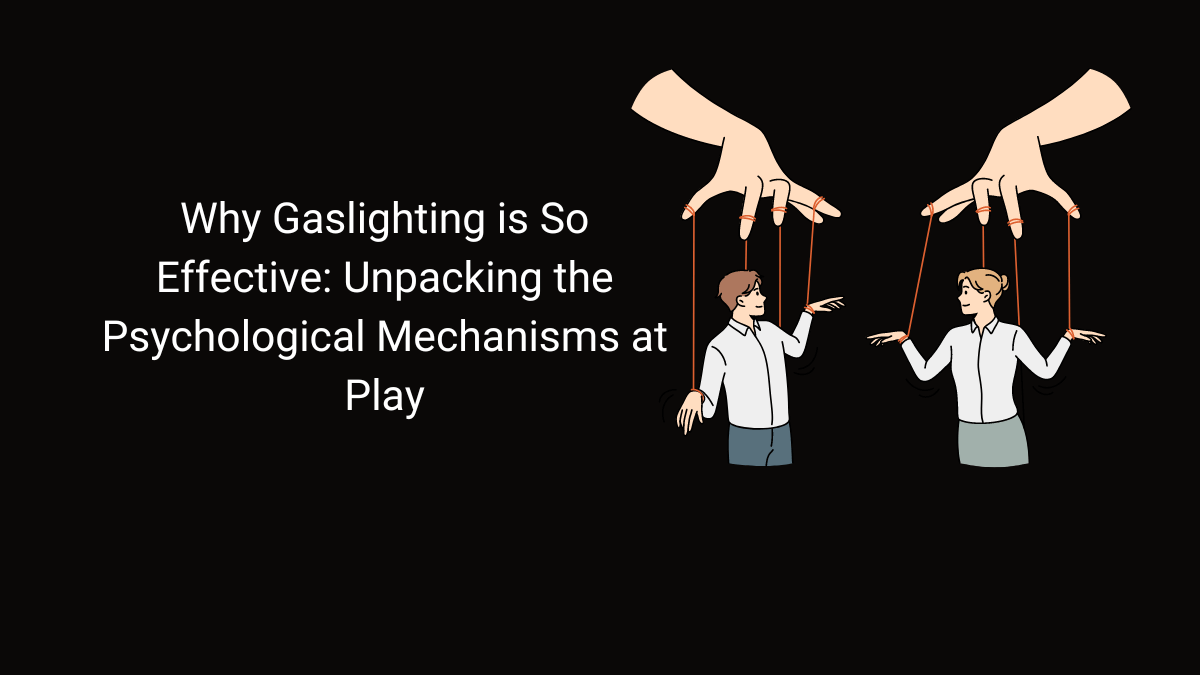Gaslighting is a form of emotional abuse that can be difficult to recognize but can have devastating effects on a person’s sense of self and reality. In this blog post, we’ll define gaslighting, explore its effectiveness, and examine the impact it has on victims. We’ll also delve into the various tactics used by gaslighters, the role of power dynamics in gaslighting, and how it can affect society as a whole.
The purpose of this blog post is to raise awareness about gaslighting, its effects, and how it can be recognized and addressed. It’s important for people to understand the signs of gaslighting so that they can protect themselves and their loved ones from this harmful form of abuse.
Definition of Gaslighting
Gaslighting is a psychological tactic that involves manipulating someone into questioning their own sanity, memory, or perception of reality. The term originated from a play and movie called “Gas Light,” in which a man tries to convince his wife that she is going insane by manipulating the gas lights in their home.
Effectiveness of gaslighting
Gaslighting is a powerful tool used by abusers and manipulators to gain control over their victims. By making the victim doubt their own perception of reality, the gaslighter can create a sense of dependency and manipulate the victim’s behavior to suit their own needs. This can lead to the victim becoming isolated from friends and family, and may cause them to doubt their own judgment, leading to self-doubt, anxiety, and depression.
The gradual erosion of reality and Gaslighting

Gaslighting is a pattern of behavior that gradually erodes a person’s sense of reality. It is a form of psychological manipulation that involves persistent and intentional efforts to make someone doubt their own perceptions, memories, and judgment. Gaslighting can be difficult to detect, as it often happens in small manipulations that add up over time.
1.How Gaslighting is a pattern of behavior?
Gaslighting is not a one-time event but a pattern of behavior that occurs over time. Gaslighters use small manipulations that add up over time, leading the victim to question their own reality.
The gaslighter will often deny that certain events or conversations ever occurred, make up stories or lies, or try to discredit the victim’s memory or perception of events.
2. The small manipulations that add up over time
Gaslighting involves small manipulations, such as changing details of a conversation, making a victim doubt their own memory, or planting false memories. These small manipulations can add up over time, leading to the victim questioning their own reality.
3. Examples of common Gaslighting tactics
The gaslighter may start with small lies or inconsistencies, which may seem harmless or inconsequential at first. Over time, these small manipulations can build up and make the victim doubt their own memory, perception, and sanity.
Some common gaslighting tactics include:
- Denial: The gaslighter may deny saying or doing something, even if there is evidence to the contrary. They may also deny the victim’s reality, telling them that their feelings or experiences are invalid or wrong.
- Withholding: The gaslighter may withhold information or support that the victim needs, making them feel isolated and helpless.
- Countering: The gaslighter may contradict the victim’s memory or perception of events, making them doubt their own reality.
- Minimization: The gaslighter may downplay the victim’s experiences or feelings, making them feel like they are overreacting or being too sensitive.
- Blaming: The gaslighter may blame the victim for their own behavior, making them feel like they are responsible for the abuse.
- Gaslighting by proxy: The gaslighter may enlist others to reinforce their version of reality and make the victim feel like they are crazy or paranoid.
All of these tactics are designed to make the victim doubt their own reality and feel like they can’t trust themselves. This erosion of reality can have serious consequences, leading to feelings of anxiety, depression, and helplessness. It can also make it difficult for the victim to leave the relationship, as they may feel like they can’t survive without the gaslighter’s validation and support.
The human need for validation and Gaslighting

Gaslighting is an insidious form of emotional abuse that is effective in part because it preys on the human need for validation. Validation is the process of confirming or verifying a person’s feelings, experiences, or beliefs. It is a crucial aspect of healthy relationships and helps individuals develop a sense of self-worth and confidence.
1.The importance of validation
Humans have a basic need for validation and validation from others is an important aspect of self-esteem and self-worth. When a person is gaslit, their sense of self is undermined, leading to confusion, self-doubt, and low self-esteem.
2. How gaslighting preys on the need for validation?
Gaslighting preys on a person’s need for validation by making them doubt their own thoughts, feelings, and experiences. The gaslighter may tell the victim that their perception of events is wrong or that they are overreacting, leading the victim to question their own judgment.
3. How gaslighting can cause self-doubt and confusion?
When someone is being gaslit, they may begin to doubt their own memory, perception, and judgment. This can lead to feelings of confusion and self-doubt, as the victim may start to question their own sanity. Gaslighting can also cause a person to feel emotionally drained, anxious, and depressed, as they struggle to understand what is happening to them.
In some cases, gaslighting can lead to a condition known as “gaslighting syndrome,” where the victim experiences long-term psychological damage. This can include symptoms such as paranoia, chronic anxiety, depression, and difficulty with relationships.
The Power of Authority and Control
Gaslighting is often used as a tool by abusers and manipulators to exert power and control over their victims. This is because gaslighting works to undermine a victim’s sense of self and reality, making them more vulnerable to the manipulator’s influence.
In this section, we will explore the role of power dynamics in gaslighting, how abusers use their power to control their victims, and the impact of gaslighting on victims’ sense of agency and autonomy.
1. The Role of Power Dynamics in Gaslighting
In many cases, gaslighting occurs in the context of a power dynamic where the gaslighter has some level of authority or influence over the victim. This could be a boss, a parent, a partner, or anyone who holds some form of power over the victim. The gaslighter uses this power to manipulate the victim’s perception of reality, often making them feel like they have no choice but to accept the gaslighter’s version of events.
2. How Abusers and Manipulators Use Their Power to Control Their Victims
Gaslighters often use their power to control their victims in a variety of ways. For example, a partner who is financially dependent on their abuser may be more likely to tolerate gaslighting in order to maintain their source of income.
Similarly, a boss who uses gaslighting tactics may be able to get their employees to work longer hours or accept unfair treatment out of fear of losing their job. In these situations, the gaslighter is able to maintain control over their victim by using their power to create a sense of dependency.
3. The Impact of Gaslighting on Victims’ Sense of Agency and Autonomy
Gaslighting can have a profound impact on a victim’s sense of agency and autonomy. When a victim’s reality is constantly being called into question, they may start to doubt their own judgment and decision-making abilities.
This can lead to a feeling of powerlessness and a lack of control over their own life. In some cases, victims of gaslighting may even start to question their own sanity, which can have a devastating impact on their mental health.
In conclusion, gaslighting is often used as a tool by abusers and manipulators to exert power and control over their victims. By undermining a victim’s sense of self and reality, gaslighters are able to maintain a sense of dominance and control.
This can have a profound impact on a victim’s sense of agency and autonomy, leading to feelings of powerlessness and a lack of control over their own life. It is important for victims of gaslighting to recognize the tactics being used against them and seek help from a trusted friend, family member, or mental health professional.
Cognitive dissonance and Gaslighting

In the context of gaslighting, cognitive dissonance plays a significant role in why it works so effectively. Let’s dive in.
1.Cognitive dissonance
Cognitive dissonance is a psychological term that refers to the mental discomfort experienced by a person who holds two or more conflicting beliefs, values, or ideas. This feeling of discomfort arises when people encounter information that challenges their existing beliefs or when their behavior contradicts their beliefs.
2. How gaslighting creates cognitive dissonance in victims?
Gaslighting is a form of manipulation that causes cognitive dissonance in its victims. The gaslighter often uses contradictory information and denies the victim’s reality, causing them to question their own beliefs, memories, and perceptions. The victim is left feeling confused and unsure of what is real and what is not.
3. How victims may justify the behavior of the gaslighter in order to alleviate their cognitive dissonance
In order to alleviate the mental discomfort caused by cognitive dissonance, victims of gaslighting may begin to justify the behavior of the gaslighter. They may begin to rationalize the gaslighter’s behavior by convincing themselves that the gaslighter is simply looking out for their best interests or that the gaslighter is going through a difficult time and needs their support.
This rationalization helps to alleviate the cognitive dissonance, but it also enables the gaslighter to continue their manipulative behavior.
Gaslighting in social and political contexts

Gaslighting is not limited to personal relationships, it can also occur in social and political contexts. In fact, gaslighting has become a common tactic in political discourse and media manipulation. In these contexts, gaslighting is often used to distort or deny objective facts in order to manipulate public opinion.
1. Examples of gaslighting in social and political contexts
Gaslighting can be seen in various forms of media, such as news broadcasts, social media, and political speeches. A recent example of gaslighting in politics is the “Big Lie” promoted by former US President Donald Trump, who claimed without evidence that the 2020 presidential election was rigged against him.
Despite numerous investigations and court rulings that found no evidence of widespread voter fraud, Trump and his supporters continued to spread the false claim, which resulted in the deadly insurrection at the US Capitol on January 6, 2021.
Another example of gaslighting in social contexts is the dismissal or denial of systemic racism or discrimination. People of color often experience gaslighting when their experiences of racism are denied or minimized by others who refuse to acknowledge the existence of systemic racism.
Gaslighting can also occur in cases of sexual assault or harassment, where victims may be dismissed or blamed for their experiences.
2. The role of gaslighting in shaping public opinion
Gaslighting in social and political contexts can have serious consequences on public opinion and societal norms. When objective facts are denied or distorted, it becomes difficult for individuals to make informed decisions and hold those in power accountable. Gaslighting can also lead to a breakdown in trust and communication between individuals and institutions, which can have long-lasting effects on democracy and society as a whole.
3. The impact of gaslighting on society and democracy
Gaslighting has the potential to undermine the foundations of democracy by eroding the trust in institutions and information. When individuals are constantly subjected to manipulation and lies, they may become cynical and disengaged from the political process.
This can lead to apathy or even hostility towards democratic institutions and values. In extreme cases, gaslighting can also contribute to the rise of authoritarian regimes, as seen in countries where political leaders have used gaslighting tactics to gain and maintain power.
Overall, gaslighting is a serious issue that can have far-reaching consequences for individuals and society. It is important to recognize the signs of gaslighting and to seek help if you are experiencing it. It is also crucial for individuals to remain vigilant and critical of information presented in the media and in political discourse, and to hold those in power accountable for their actions.
Recap
In this blog post, we have explored the insidious behavior of gaslighting and its damaging effects on victims. We started with a definition of gaslighting, explaining how it is a manipulative tactic used to control and undermine someone’s sense of reality. We then discussed how gaslighting is a pattern of behavior that involves small manipulations that add up over time, causing victims to doubt their own perceptions and memories.
Next, we examined the importance of validation and how gaslighting preys on the human need for validation, causing victims to question themselves and their own worth. We also discussed the role of power dynamics in gaslighting, and how abusers and manipulators use their power to control their victims, impacting their sense of agency and autonomy.
We then delved into cognitive dissonance and how gaslighting creates cognitive dissonance in victims, leading them to justify the behavior of the gaslighter in order to alleviate their own discomfort and confusion. Finally, we explored the social and political contexts of gaslighting, and how it can be used to shape public opinion and undermine democracy.
Final Thoughts
In conclusion, it is crucial to recognize and address gaslighting in all its forms. Victims of gaslighting may experience feelings of self-doubt, confusion, and isolation, but there are resources available to help them.
It is important to reach out to friends, family, and professionals for support and to educate ourselves on the tactics of gaslighting so we can recognize and resist them. Let us work together to create a society where gaslighting is not tolerated and where everyone’s sense of reality is respected and validated.


